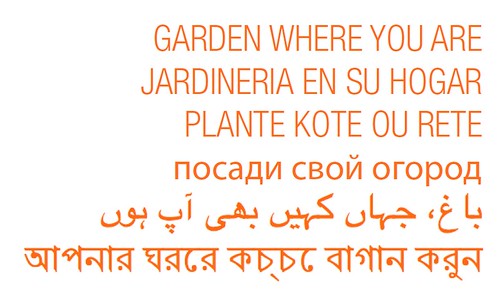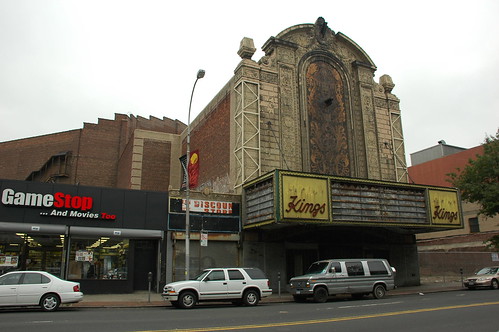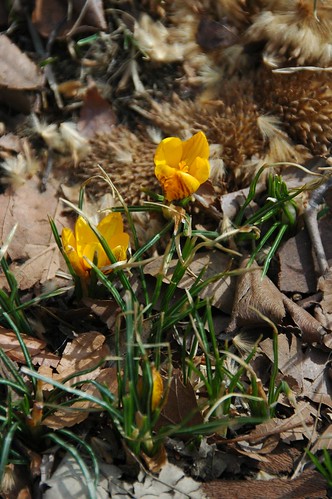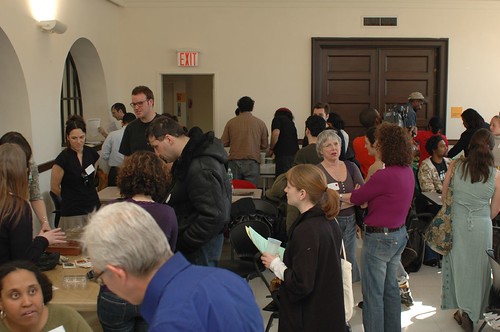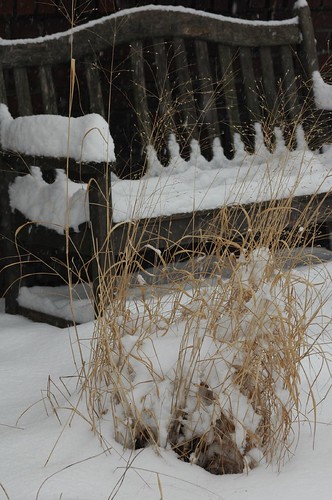Over the weekend, my Twitter stream reflected the progress I was making on my final class project for the Urban Garden Design class with Nigel Rollings at the Brooklyn Botanic Garden. Despite battling a wicked head hold and racking cough, I put the finishing touches on my design late Monday night.
A cultivar of Lonicera sempervirens, the native Trumpet Honeysuckle, growing on a metal arbor at the entrance to my backyard. The specific epithet “sempervirens” refers to the evergreen, or nearly so in my Zone 7a/6b garden, foliage.

In last night’s class we each presented our designs. There was a lot of warmth, humor, and enthusiasm among the class. Not to mention wine (though not for me). The night ran late, so there wasn’t time for close inspection of all the designs.
Some of my fellow students wanted more information about my plant selections. Here is the plant list, without further explanation for now, that I used in my design. Most of these are shrubs. Many of these I’ve collected over the past several years, and some are now several feet high and wide. Many, but not all, are species native to New York City. The most precious to me are those that have been propagated from NYC-local ecotypes.
This is just a candidate list, not a final one. As I mentioned in last night’s class, I’m not satisfied with the planting plan. I would like a couple more evergreen plants; I’d really like an Ilex opaca, but the native form gets too large for my site. There are many plants in this list that provide winter interest, in bark, form, berries, and so on, including some that are semi-evergreen. I want to place more vines in the design, and I already have some ideas for where to do that. And I didn’t spend much time specifying perennials. There’s still plenty of room for them in this design; there are at least a hundred to select from, and I just ran out of time to specify and draw them all.
Trees
- Sassafras albidum, Sassafras. This would become the focal point of the garden; the design “rotates” around it. This will be a canopy tree, providing primary shade to the house and garden.
- Amelanchier arborea, Common or Downy Serviceberry. This is an understory tree from the Rosaceae, the Rose Family, tolerant of the shade the Sassafras will provide. In my design, its placement will also grant it direct afternoon sun from the West during the summer months, which should help in fruit-set. It’s a “replacement” for the old apple tree that grew on the other side of the fence on my neighbor’s property, which they had to take down last winter. I miss that tree; it was a bird magnet. This tree is a better selection, better placed, and with fewer maintenance issues.
All Amelanchier species, commonly known as Serviceberries, are desireable landscape trees and shrubs and provide food for wildlife, especially birds. Alternatives to A. arborea are A. canadensis, Canada or Shadblow Serviceberry, or Shadbush, or A. laevis, Allegheny or Smooth Serviceberry, which is recommended for its human-edible fruit.
- Prunus variety. This is an existing tree, the only one remaining from the eight trees that were in the backyard when we bought the property four years ago. It’s healthy, and adds some interest to every season, so I’m happy to keep it as long as it does well. But my design doesn’t depend on it, so when the time comes and it needs to go, the design will remain whole.
Geothlypis trichas, Common Yellowthroat, one of the avian visitors to my neighbor’s apple tree which I hope will be enticed to return by the Serviceberry.
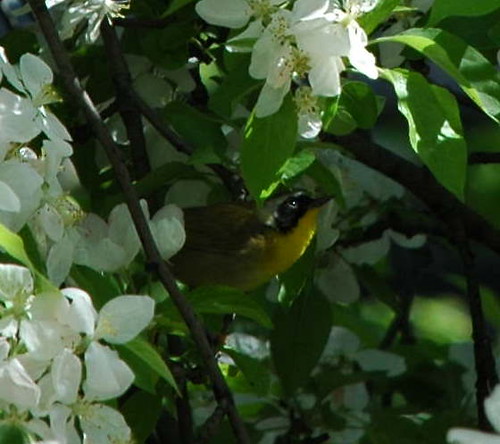
Vines
- Lonicera sempervirens cultivar (existing), Trumpet Honeysuckle. Semi-evergreen, twining vine. Flowers best and grows densest with full sun. Grows well, just less vigorously, in partial shade. Mine is visited by hummingbirds every year, but they always seem disappointed by it; it’s not the Hummingbird magnet I hoped it would be. I suspect I would need a local ecotype, one adapted to the phenology of hummingbird migration through this area, to attract hummingbirds well.
- Parthenocissus quinquefolia, Virgina Creeper. deciduous vine, climbs by holdfasts to any vertical surface; can also grow as a groundcover. A native alternative to P. tricuspidata, Boston Ivy. Deciduous. Brilliant red color in the fall. Fruit are an important food source for birds.
- Vitis labrusca, Fox Grape. Deciduous vine, climbs by tendrils. One of several native grape species, this is the source of the Concord Grape.
I also have an existing small-leaved Aristolochia, Pipevine, but I couldn’t place it yet in the new design. I want to add more vines, including the big-leaved Pipevine; I just need to think more about their placement and function.
Shrubs
- Aronia arbutifolia ‘Brilliantissimum’ (existing)
- Clethra alnifolia ‘September Beauty’ (existing)
- Cornus sericea ‘Cardinal’ (existing)
- Ilex verticillata cultivars, male and female (existing)
- Juniperus horizontalis
- Kalmia latifolia ‘Minuet’ (existing)
- Lindera benzoin
- Myrica pensylvanica
- Prunus maritima
- Rhododendron viscosum NYC-local ecotype (existing)
- Rosa carolina (or R. virginiana)
Several shrubs I already have did not make it into this design. I’ve collected them over the years without a plan, based more on their availability and opportunity to acquire them than anything else. Unless I leave no space for people, there simply isn’t enough room for all of them in my 30’x30′ backyard, which is already quite expansive by NYC, even Brooklyn, standards. That gives me some flexibility in the planting plan, as my first choice is to go with plants I already have, but some will eventually have to live on somewhere else.
[TinyURL]
Related Content
Posts
Growing a native plant garden in a Flatbush backyard, 2007-08-06
Photos
Ilex verticillata, Wiinterberry (Flickr photo set)
Lonicera sempervirens, Trumpet Honeysuckle (Flickr photo set)
Flickr photo set of my backyard


